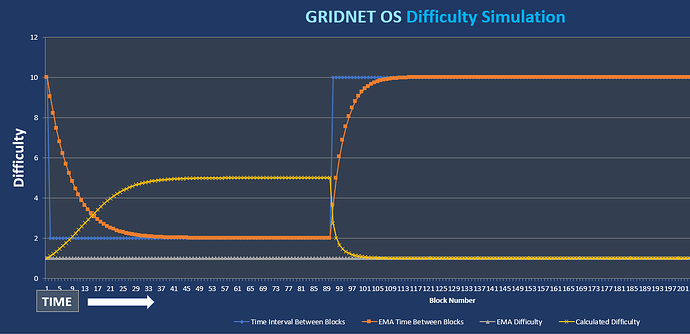Adaptive Difficulty Adjustment in Blockchain: Harnessing the Power of Exponential Moving Average (EMA) and Innovative Alpha Adjustments—
Overview
The Difficulty Adjustment Algorithm is a crucial component of the blockchain network designed to ensure consistent block intervals. This dynamic algorithm optimizes the difficulty level by monitoring recent network activities. It uses mathematical models like Exponential Moving Average (EMA) and, for reporting purposes, Simple Moving Average (SMA).
In the world of blockchain technology, maintaining a balanced pace of block creation is essential to ensure network security, stability, and efficiency. Mining difficulty adjustment mechanisms play a pivotal role in this aspect, regulating the computational effort required to add new blocks to the blockchain. This article delves into the intricate process of adjusting mining difficulty, outlining the constants involved and rationalizing their respective values.
1. Mining Difficulty and its Importance:
Mining difficulty is a measure of the computational effort needed to mine a new block. It is dynamically adjusted to maintain a consistent block generation time, ensuring that the blockchain doesn’t grow too rapidly or too slowly. This dynamism is crucial to adapting to changes in the total hashing power of the network and external factors that can impact the rate of block generation.
2. Employing Moving Averages:
Two types of moving averages are central to this mechanism - Simple Moving Average (SMA) and Exponential Moving Average (EMA). The EMA, with its ability to give more weight to recent data, is particularly significant in calculating and adjusting mining difficulty. It ensures that the mechanism responds effectively to abrupt changes in network activity.
In the world of blockchain, ensuring the security, stability, and efficient processing of transactions is paramount. One of the pivotal elements in achieving this balance is the difficulty adjustment mechanism. Traditional systems typically employ a consistent difficulty adjustment, based on a pre-defined formula. However, as blockchain networks evolve and grow in complexity, there is a pressing need for more dynamic and adaptive methods. One such method gaining traction is the Exponential Moving Average (EMA), which, when combined with innovative adjustments, offers a promising avenue for more efficient and responsive blockchain operations.
Embracing the Exponential Moving Average (EMA)
The EMA is not a new concept, having its roots in the financial sector for stock price analysis. However, its application in the blockchain realm is revolutionary. By employing EMA over both the blockchain’s block intervals and difficulty, we introduce a system that is more reactive to recent network activities and conditions.
Indeed, why EMA Over Simple Moving Average (SMA)?
While SMA gives equal weight to all values, EMA, on the other hand, places more emphasis on recent data points. This is crucial in blockchain operations, where recent block intervals and their associated difficulties are more representative of the current network state than older ones. By giving more weight to the latest data, EMA ensures the blockchain’s difficulty adjustment mechanism is more in tune with real-time network conditions, resulting in a smoother and more efficient operation.
Innovative Alpha Adjustments: A Game-Changer
The power of EMA lies in its smoothing factor, commonly referred to as alpha. In traditional settings, alpha remains constant, providing consistent weight to recent data points. However, in our approach, we introduce an innovative twist by dynamically adjusting alpha based on the block’s position within the observation window.
The formula adjustedAlpha = baseAlpha + blockIndex * some_small_factor underpins this innovation. Here, baseAlpha is the foundational smoothing factor, and blockIndex represents the block’s position within the window. The some_small_factor is a minuscule value that, when multiplied by the block index, offers a minute but impactful adjustment to the base alpha. This ensures that as we move through the observation window, each subsequent block has a slightly increased influence on the EMA, reflecting its recency and relevance.
This innovative approach to adjusting alpha is groundbreaking in decentralized blockchain systems. It offers a nuanced layer of responsiveness, ensuring the system is not only reactive to recent data but also considers the position of that data within the observation framework. This results in a more adaptive and resilient difficulty adjustment mechanism, enhancing the blockchain’s efficiency and robustness.
3. Constants and Parameters:
a. baseAlpha (0.117782101):
The baseAlpha is a smoothing factor integral to the calculation of the EMA. It is derived from the formula 2.0 / (windowSize + 1.0), ensuring a balanced responsiveness of the EMA to fluctuations in block generation time.
b. windowSize:
This parameter determines the number of previous blocks considered for calculating moving averages. Its value impacts the baseAlpha, with a smaller windowSize leading to a more responsive EMA and vice versa.
c. targetTime:
Represented by CGlobalSecSettings::getTargetedBlockInterval(), this constant is the desired average time interval between blocks. The mining difficulty is adjusted to keep the actual time close to this target.
4. Mechanism Workflow:
The mechanism initiates by validating the essential data and parameters. It then proceeds to calculate the EMA of the time between blocks, using either cached values for real-time efficiency or computing them afresh for accuracy. The actual mining difficulty is then adjusted based on the discrepancy between the targetTime and the calculated EMA of the time between blocks.
5. Edge Cases and Safety Protocols:
The mechanism is designed with considerations for thread safety and error handling to ensure robust performance. It accounts for various scenarios and anomalies, ensuring that the mining difficulty is adjusted in a manner that maintains the integrity and functionality of the blockchain.
The mining difficulty adjustment mechanism is an elegant solution to one of the most critical challenges in blockchain technology - maintaining a stable and secure rate of block generation. By adeptly balancing constants like baseAlpha, windowSize, and targetTime, and employing the precision of moving averages, this mechanism ensures that the blockchain operates efficiently, adapting dynamically to variations in network activity and external influences.
Exponential Moving Average (EMA)
EMA is a weighted average of a set of values, where more recent values are given higher weights. It reacts more quickly to recent changes in the data set, making it ideal for systems like blockchain where conditions can change rapidly.
The formula for calculating EMA is:

Where:
valueis the current observation.ALPHAis a coefficient that determines the rate at which the EMA adapts. A higherALPHAgives more weight to recent values.
Dynamically Adjusted ALPHA
A dynamically adjusted ALPHA means that its value isn’t constant. Depending on certain conditions, ALPHA can be tweaked. Typically, if the network or system undergoes rapid changes, a higher ALPHA might be employed to make the EMA more responsive.
The choice to adjust ALPHA can be based on various factors such as:
- Volatility in observed block times.
- Network participation changes.
- Detected attacks or anomalies.
Simple Moving Average (SMA) for Reporting
While EMA is employed for adjusting the difficulty dynamically, SMA is used for reporting purposes. SMA gives an average of the dataset without giving weights, making it easier to interpret and understand the broader trends without the nuances of EMA.
The formula for calculating SMA is:

Where:
valuesis the set of observed values.number of valuesis the count of observations in the set.
Difficulty Adjustment Mechanism
-
Observation Collection: The system collects a series of recent block intervals (the time it took to find each recent block). These form the basis for our calculations.
-
EMA Calculation: Using the series of block intervals and the dynamically adjusted
ALPHA, the system calculates the EMA. -
Difficulty Adjustment: The new difficulty is then set based on the EMA. If the EMA of block intervals is less than the desired block time, the difficulty is increased. If the EMA is higher, the difficulty is decreased.
-
SMA Reporting: An SMA of the block intervals is calculated and reported. This provides a clearer, non-weighted view of recent block times, which can be useful for diagnostics and system insights.
Employing Exponential Moving Average (EMA) in Blockchain: A Deeper Dive
When we talk about the core of the difficulty adjustment mechanism in blockchain systems, the Exponential Moving Average (EMA) stands out as a central component. Not only does it capture the essence of recent changes in block generation times and difficulty levels, but it also ensures the blockchain’s adaptive and dynamic nature. Let’s further explore how EMA is employed over both block intervals and difficulty in the blockchain.
6. Understanding EMA:
The Exponential Moving Average gives more weight to the latest data points and less weight to older ones, making it more responsive to recent changes compared to a Simple Moving Average (SMA). This responsiveness is what makes EMA an attractive choice for blockchain systems, where block generation times can fluctuate due to varying factors like total hashing power or network congestion.
7. EMA of Block Intervals:
Block intervals refer to the time taken between the generation of two consecutive blocks. To keep the pace of block generation steady, we must adjust the difficulty based on the average block interval.
By employing the EMA formula over the block intervals, we can calculate an averaged block interval, factoring in recent intervals more heavily. If blocks are being produced too quickly, the mechanism will recognize this through the EMA of the block intervals and adjust the difficulty upwards. Conversely, if blocks are being produced too slowly, the difficulty will be adjusted downwards.
8. EMA of Difficulty:
Similar to block intervals, the difficulty of mining also requires an averaged value to guide adjustments. By applying EMA to the difficulty values of past blocks, we generate a more responsive and up-to-date average difficulty.
For instance, if the latest blocks in the sequence have been particularly challenging to mine, the EMA of difficulty will be higher than if the last few blocks were easier. This sensitivity to recent changes ensures that the mechanism can adjust the difficulty proactively.
9. Dynamic Smoothing with adjustedAlpha:
While the base smoothing factor, baseAlpha, plays a crucial role, there’s an additional layer of dynamism introduced by the adjustedAlpha. This value incorporates a small factor, typically a value close to zero, that scales with the block index. By doing so, the weight of the latest blocks in the EMA calculation can be slightly adjusted, ensuring an even more adaptive response.
10. Final Difficulty Adjustment:
Once the EMA values for both block intervals and difficulty are computed, the mechanism evaluates the current difficulty. The aim is to align the EMA of block intervals with the target block interval. The formula used is:

Here, if the EMA of block intervals is greater than the target, the difficulty will increase, and vice versa.
Combatting Timestamp Manipulation and Miners’ Gaming Tactics: The Resilience of the New Mechanism
Shielding Against Timestamp Manipulation
Timestamp manipulation attacks are among the most common vulnerabilities blockchain networks face. Malicious actors manipulate block timestamps to influence the difficulty adjustment algorithm, aiming to produce blocks at a faster rate than intended. This compromises the stability and security of the network.
Our novel difficulty adjustment mechanism, which leverages a dynamic Exponential Moving Average (EMA) combined with adaptive alpha adjustments, offers inherent resistance against such attacks. Here’s how:
-
Emphasis on Recent Data: By prioritizing recent blocks when determining difficulty adjustments through the EMA, we diminish the impact of any anomalous block intervals introduced by malicious actors. This is because the influence of older blocks, which may have manipulated timestamps, diminishes rapidly.
-
Innovative Alpha Adjustments: The dynamic adjustment of alpha, based on the block’s position within the observation window makes it even more challenging for attackers. This is because the further the malicious block is from the present, the less influence it has, making any attempt at prolonged manipulation increasingly ineffective.
Thwarting Powerful Miners from Gaming the System
Powerful miners with high computational capabilities, such as those using NVIDIA’s GeForce RTX 4090 GPUs, often employ a tactic known as “difficulty hopping” or “pool hopping”. They join a network when the difficulty is low, benefit from mining rewards, and then leave abruptly, causing the difficulty to drop. This oscillating behavior disrupts the blockchain’s equilibrium and can lead to unfair distribution of rewards.
The adaptive EMA-based difficulty adjustment system serves as a countermeasure against such strategies:
-
Rapid Response to Network Changes: The emphasis on recent blocks ensures that the system quickly reacts to sudden influxes or departures of powerful miners. If a group of powerful miners joins and starts producing blocks faster than the target rate, the difficulty will adjust upwards faster, reducing their undue advantage.
-
Preventing Drastic Difficulty Drops: The innovative alpha adjustment ensures that even if powerful miners leave abruptly, the difficulty doesn’t plummet immediately. The system will gradually adjust, ensuring that remaining miners aren’t left with an insurmountable difficulty.
-
Deterring Short-Term Mining: The nuanced adjustment makes it less profitable for miners to join only for short spurts when the difficulty is low. The rapid reaction of the system ensures that these miners can’t reap disproportionate rewards and then leave without contributing to the network’s long-term stability.
Conclusion
In the ever-competitive world of blockchain, where both external attackers and powerful internal actors pose threats, having a robust and adaptive difficulty adjustment mechanism is paramount. Our new system, built on the principles of Exponential Moving Average and innovative alpha adjustments, offers the resilience needed to maintain network stability, fairness, and security.
EMA’s application in adjusting mining difficulty showcases its efficiency and adaptability. By weighing recent data more heavily, the blockchain system can make informed decisions on difficulty adjustments, ensuring stability, security, and consistent block generation times.
The Difficulty Adjustment Algorithm ensures that the blockchain network remains robust and adaptive to varying conditions. By employing
EMA, the algorithm can rapidly adjust to recent changes, while the SMA provides a straightforward overview of block times. Together, these mechanisms maintain consistent block intervals, optimizing security and efficiency.
Feel invited to take look at the attached Simulator in Excel and feel even more encouraged to experiment and see how the values change for yourself!
GRIDNET Difficulty SImulator.zip (45.2 KB)






